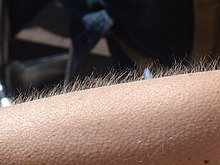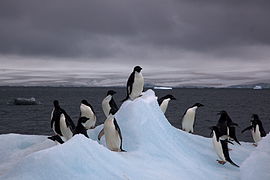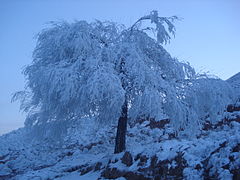Cold




Coldis the presence of lowtemperature,especially in the atmosphere. In common usage, cold is often asubjective perception.A lower bound to temperature isabsolute zero,defined as 0.00K on theKelvinscale, an absolutethermodynamic temperaturescale. This corresponds to −273.15 °C on theCelsius scale,−459.67 °F on theFahrenheit scale,and 0.00 °R on theRankine scale.
Since temperature relates to thethermal energyheld by an object or a sample of matter, which is thekinetic energyof the random motion of the particle constituents of matter, an object will have less thermal energy when it is colder and more when it is hotter. If it were possible to cool a system to absolute zero, all motion of the particles in a sample of matter would cease and they would be at complete rest in theclassicalsense. The object could be described as having zero thermal energy. Microscopically in the description ofquantum mechanics,however, matter still haszero-point energyeven at absolute zero, because of theuncertainty principle.
Cooling[edit]
Cooling refers to the process of becoming cold, or lowering intemperature.This could be accomplished by removing heat from a system, or exposing the system to an environment with a lower temperature.
Coolantsarefluidsused to cool objects, prevent freezing and prevent erosion in machines.[2]
Air coolingis the process of cooling an object by exposing it toair.This will only work if the air is at a lower temperature than the object, and the process can be enhanced by increasing thesurface area,increasing the coolant flow rate, or decreasing themassof the object.[3][better source needed]
Another common method of cooling is exposing an object toice,dry ice,orliquid nitrogen.This works byconduction;the heat is transferred from the relatively warm object to the relatively cold coolant.[4]
Laser coolingandmagnetic evaporative coolingare techniques used to reach very low temperatures.[5][6]
History[edit]
Early history[edit]
In ancient times, ice was not adopted forfood preservationbut used to cool wine which the Romans had also done. According toPliny,Emperor Neroinvented the ice bucket to chill wines instead of adding it to wine to make it cold as it would dilute it.[7]
Some time around 1700 BCZimri-Lim,king ofMari Kingdomin northwest Iraq had created an "icehouse" calledbit shurpinat a location close to his capital city on the banks of theEuphrates.In the 7th century BC the Chinese had used icehouses to preserve vegetables and fruits. During theTang dynastic rulein China (618–907 AD) a document refers to the practice of using ice that was in vogue during theEastern Chou Dynasty(770–256 BC) by 94 workmen employed for "Ice-Service" to freeze everything from wine to dead bodies.[7]
Shachtman says that in the 4th century AD, the brother of the Japanese emperorNintokugave him a gift of ice from a mountain. The Emperor was so happy with the gift that he named the first of June as the "Day of Ice" and ceremoniously gave blocks of ice to his officials.[7]
Even in ancient times, Shachtman says, in Egypt and India, night cooling by evaporation of water and heat radiation, and the ability of salts to lower the freezing temperature of water was practiced. The ancient people of Rome and Greece were aware that boiled water cooled quicker than the ordinary water; the reason for this is that with boiling of watercarbon dioxideand other gases, which are deterrents to cooling, are removed; but this fact was not known till the 17th century.[7]
From the 17th century[edit]
Shachtman says that KingJames VI and Isupported the work ofCornelis Drebbelas a magician to perform tricks such as producing thunder, lightning, lions, birds, trembling leaves and so forth. In 1620 he gave a demonstration in Westminster Abbey to the king and his courtiers on the power of cold.[8]On a summer day, Shachtman says, Drebbel had created a chill (lowered the temperature by several degrees) in the hall of the Abbey, which made the king shiver and run out of the hall with his entourage. This was an incredible spectacle, says Shachtman. Several years before,Giambattista della Portahad demonstrated at the Abbey "ice fantasy gardens, intricate ice sculptures" and also iced drinks for banquets inFlorence.The only reference to the artificial freezing created by Drebbel was byFrancis Bacon.His demonstration was not taken seriously as it was considered one of his magic tricks, as there was no practical application then. Drebbel had not revealed his secrets.[9]
Shachtman says that Lord Chancellor Bacon, an advocate of experimental science, had tried inNovum Organum,published in the late 1620s, to explain the artificial freezing experiment at Westminster Abbey, though he was not present during the demonstration, as "Nitre(or rather its spirit) is very cold, and hence nitre or salt when added to snow or ice intensifies the cold of the latter, the nitre by adding to its own cold, but the salt by supplying activity to the cold snow. "This explanation on the cold inducing aspects ofnitreand salt was tried then by many scientists.[10]
Shachtman says it was the lack of scientific knowledge in physics and chemistry that had held back progress in the beneficial use of ice until a drastic change in religious opinions in the 17th century. The intellectual barrier was broken by Francis Bacon andRobert Boylewho followed him in this quest for knowledge of cold.[11]Boyle did extensive experimentation during the 17th century in the discipline of cold, and his research on pressure and volume was the forerunner of research in the field of cold during the 19th century. He explained his approach as "Bacon's identification of heat and cold as the right and left hands of nature".[12]Boyle also refuted some of the theories mooted byAristotleon cold by experimenting on transmission of cold from one material to the other. He proved that water was not the only source of cold but gold, silver and crystal, which had no water content, could also change to severe cold condition.[13]
19th century[edit]

In the United States from about 1850 till end of 19th century export of ice was second only to cotton. The first ice box was developed by Thomas Moore, a farmer fromMarylandin 1810 to carry butter in an oval shaped wooden tub. The tub was provided with a metal lining in its interior and surrounded by a packing of ice. A rabbit skin was used as insulation. Moore also developed an ice box for domestic use with the container built over a space of 6 cubic feet (0.17 m3) which was filled with ice. In 1825, ice harvesting by use of a horse drawn ice cutting device was invented by Nathaniel J. Wyeth. The cut blocks of uniform size ice was a cheap method of food preservation widely practiced in the United States. Also developed in 1855 was a steam powered device to haul 600 tons of ice per hour. More innovations ensued. Devices using compressed air as a refrigerants were invented.[14]
20th century[edit]
Iceboxeswere in widespread use from the mid-19th century to the 1930s, when therefrigeratorwas introduced into the home. Most municipally consumed ice was harvested in winter from snow-packed areas or frozen lakes, stored inice houses,and delivered domestically as iceboxes became more common.
In 1913, refrigerators for home use were invented. In 1923 Frigidaire introduced the first self-contained unit. The introduction ofFreonin the 1920s expanded the refrigerator market during the 1930s.[15]Home freezers as separate compartments (larger than necessary just for ice cubes) were introduced in 1940. Frozen foods, previously a luxury item, became commonplace.
Physiological effects[edit]
Cold has numerousphysiologicalandpathologicaleffects on thehuman body,as well as on other organisms. Cold environments may promote certainpsychologicaltraits, as well as having direct effects on the ability to move.Shiveringis one of the first physiological responses to cold.[16]Even at low temperatures, the cold can massively disrupt blood circulation. Extracellular water freezes and tissue is destroyed. It affects fingers, toes, nose, ears and cheeks particularly often. They discolor, swell, blister, and bleed. Local frostbite leads to so-calledchilblainsor even to the death of entire body parts. Only temporary cold reactions of the skin are without consequences. As blood vessels contract, they become cool and pale, with less oxygen getting into the tissue. Warmth stimulates blood circulation again and is painful but harmless. Comprehensive protection against the cold is particularly important for children and for sports. Extreme cold temperatures may lead tofrostbite,sepsis,andhypothermia,which in turn may result in death.[17][18]
Common myths[edit]
Acommon, but false, statementstates that cold weather itself can induce the identically namedcommon cold.[19]No scientific evidence of this has been found, although the disease, alongsideinfluenzaand others, doesincrease in prevalencewith colder weather.
Notable cold locations and objects[edit]


- TheNational Institute of Standards and Technologyin Boulder, Colorado using a new technique, managed to chill a microscopic mechanical drum to 360 microkelvins,making it the coldest object on record. Theoretically, using this technique, an object could be cooled to absolute zero.[20]
- The coldest known temperature ever achieved is astate of mattercalled theBose–Einstein condensatewhich was first theorized to exist bySatyendra Nath Bosein 1924 and first created byEric Cornell,Carl Wieman,and co-workers atJILAon 5 June 1995. They did this by cooling a dilute vapor consisting of approximately two thousandrubidium-87atoms to below 170 nK (one nK or nanokelvin is a billionth (10−9) of akelvin) using a combination oflaser cooling(a technique that won its inventorsSteven Chu,Claude Cohen-Tannoudji,andWilliam D. Phillipsthe 1997Nobel Prize in Physics) andmagnetic evaporative cooling.[21]
- 90377 Sednais one of the coldest known objects within theSolar System.Orbiting at an average distance of 84 billion miles, Sedna has an average surface temperature of -400°F (-240°C).[22]
- The lunar craterHermitewas described after a 2009 survey byNASA'sLunar Reconnaissance Orbiteras the "coldest known place in the Solar System", with temperatures at 26kelvins(−413 °F, −247 °C).[23]
- TheBoomerang Nebulais the coldest known natural location in theuniverse,with a temperature that is estimated at 1K(−272.15 °C, −457.87 °F).[24]
- The Dwarf PlanetHaumeais one of the coldest known objects in our solar system. With a Temperature of -401 degreesFahrenheitor -241 degreesCelsius[25]
- ThePlanckspacecraft's instruments are kept at 0.1K(−273.05 °C, −459.49 °F) via passive and active cooling.[26]
- Absent any other source of heat, the temperature of the Universe is roughly 2.725kelvins,due to theCosmic microwave background radiation,a remnant of theBig Bang.[27]
- Neptune's moonTritonhas a surface temperature of 38.15 K (−235 °C, −391 °F)[28]
- Uranuswith ablack-bodytemperature of 58.2 K (−215.0 °C, −354.9 °F).[29]
- Saturnwith a black-body temperature of 81.1 K (−192.0 °C, −313.7 °F).[30]
- Mercury,despite being close to the Sun, is actually cold during its night, with a temperature of about 93.15 K (−180 °C, −290 °F). Mercury is cold during its night because it has noatmosphereto trap inheatfrom the Sun.[31]
- Jupiterwith a black-body temperature of 110.0 K (−163.2 °C, −261.67 °F).[32]
- Marswith a black-body temperature of 210.1 K (−63.05 °C, −81.49 °F).[33]
- The coldest continent onEarthisAntarctica.[34]The coldest place on Earth is theAntarctic Plateau,[35]an area of Antarctica around theSouth Polethat has analtitudeof around 3,000 metres (9,800 ft). The lowest reliably measured temperature on Earth of 183.9 K (−89.2 °C, −128.6 °F) was recorded there atVostok Stationon 21 July 1983.[36]ThePoles of Coldare the places in theSouthernandNorthern Hemisphereswhere the lowest air temperatures have been recorded. (SeeList of weather records).[37]
- The cold deserts of theNorth Pole,known as the tundra region, experiences an annual snow fall of a few inches and temperatures recorded are as low as 203.15 K (−70 °C, −94 °F). Only a few small plants survive in the generally frozen ground (thaws only for a short spell).[38]
- Cold deserts of the Himalayas are a feature of a rain-shadow zone created by the mountain peaks of the Himalaya range that runs fromPamir Knotextending to the southern border of theTibetan plateau;however this mountain range is also the reason for the monsoon rain fall in theIndian subcontinent.This zone is located in an elevation of about 3,000 m, and coversLadakh,Lahaul,SpitiandPooh.In addition, there are inner valleys within the main Himalayas such asChamoli,some areas ofKinnaur,Pithoragarhand northernSikkimwhich are also categorized as cold deserts.[39]
-
Cold desert of the Himalayas inLadakh
-
Tree with hoarfrost
-
Frozen Saint Lawrence River
-
Winter sea ice
-
Ice climbing
Mythology and culture[edit]
- Niflheimwas a realm of primordial ice and cold with nine frozen rivers inNorse Mythology.[40]
- The "Hell in Dante's Inferno" is stated asCocytusa frozen lake where Virgil and Dante were deposited.[41]
See also[edit]
- Technical, scientific
- Chiller– Machine that removes heat from a liquid coolant via vapor compression
- Cryogenics– Study of the production and behaviour of materials at very low temperatures
- Cryosphere– Earth's surface where water is frozen
- Freezing point– Temperature at which a solid turns liquid
- Negative temperature– Physical systems hotter than any other
- Coldness– Measure of the coldness of a system
- Ultracold atom– Atoms kept at temperatures close to absolute zero
- Entertainment, myth
- Ice cream– Frozen dessert
- Indrid Cold
- Snowball– Spherical object made from compacted snow
- Snowman– Figure sculpted from snow
- Winter sport– Sports or recreational activities which are played on snow or ices
- Meteorological:
- Atmospheric inversion– Deviation from the normal change of an atmospheric property with altitude
- Cold front– Leading edge of a cooler mass of air
- Freezing rain– Rain maintained at temperatures below freezing
- Frost– Coating or deposit of ice
- Hail– Form of solid precipitation
- Sleet– Form of precipitation consisting of rain and melting snow
- Snow– Precipitation in the form of ice crystal flakes
- Geographical and climatological:
- Glacier– Persistent body of ice that is moving downhill under its own weight
- Ice cap– Ice mass that covers less than 50,000 km² of land area
- Ice cap climate– Polar climate where no mean monthly temperature exceeds 0 °C (32 °F)
- Ice sheet– Large mass of glacial ice
References[edit]
- ^Scuba Diving – Hand SignalsArchived14 April 2009 at theWayback Machine
- ^"An Introduction to Coolant Technology".coolantexperts.Archivedfrom the original on 23 February 2016.Retrieved15 February2016.
- ^"Air Cooling".techopedia.Archivedfrom the original on 2 March 2016.Retrieved16 February2016.
- ^"When you add energy to an object and the object warms, what exactly is happening inside the object?".atmo.arizona.edu.Archivedfrom the original on 16 September 2015.Retrieved16 February2016.
- ^"Laser Cooling".hyperphysics.phy-astr.gsu.edu.Archivedfrom the original on 31 January 2016.Retrieved15 February2016.
- ^"The basic idea of the evaporative cooling is simple".cold-atoms.physics.lsa.umich.edu.Archivedfrom the original on 9 December 2015.Retrieved15 February2016.
- ^abcdShachtman 2000,p. 17.
- ^Shachtman 2000,p. 4.
- ^Shachtman 2000,pp. 8–9.
- ^Shachtman 2000,pp. 12–13.
- ^Shachtman 2000,pp. 18–25.
- ^Shachtman 2000,pp. 25–26.
- ^Shachtman 2000,p. 28.
- ^Flynn 2004,p. 23.
- ^"The Story of the Refrigerator".aham.org.Association of Home Appliance Manufacturers. Archived fromthe originalon 5 March 2016.Retrieved16 February2016.
- ^Mayo Clinic staff."Hypothermia: Symptoms".Mayo Clinic.Archivedfrom the original on 4 February 2016.Retrieved15 February2016.
- ^Ellen Goldbaum (2 February 2016)."Shocked by frostbite amputations, med students take action".UB Reporter.Archived fromthe originalon 4 March 2016.Retrieved15 February2016.
- ^This is how cold protection works in winter (German) - Alpin 01/2007
- ^Zuger, Abigail (4 March 2003)."'You'll Catch Your Death!' an Old Wives' Tale? Well.. "The New York Times.
- ^Clark, Jeremy B.; Lecocq, Florent; Simmonds, Raymond W.; Aumentado, José; Teufel, John D. (11 January 2017). "Sideband cooling beyond the quantum backaction limit with squeezed light".Nature.541(7636): 191–195.arXiv:1606.08795.Bibcode:2017Natur.541..191C.doi:10.1038/nature20604.PMID28079081.S2CID4443249.
- ^"The Nobel Prize in Physics 1997".Archivedfrom the original on 24 September 2015.
- ^"Mysterious Sedna | Science Mission Directorate".science.nasa.gov.Archived fromthe originalon 16 May 2017.Retrieved28 February2023.
- ^Amos, Jonathan (16 December 2009)."'Coldest place' found on the Moon ".BBC.Retrieved17 December2009.
- ^"Boomerang Nebula boasts the coolest spot in the Universe".NASA's Jet Propulsion Laboratory. 20 June 1997.Archivedfrom the original on 27 August 2009.Retrieved8 July2009.
- ^"By the Numbers | Haumea".
- ^Staff (7 July 2009)."Coldest Known Object in Space Is Very Unnatural".Space.Archivedfrom the original on 3 July 2013.Retrieved3 July2013.
- ^Hinshaw, Gary (15 December 2005)."Tests of the Big Bang: The CMB".NASA WMAP.Archivedfrom the original on 20 March 2008.Retrieved9 January2007.
- ^"Voyager the Interstellar Mission".NASA: Jet Propulsion Laboratory, California Institute of Technology.Archived fromthe originalon 20 December 2007.Retrieved15 February2016.
- ^"Uranus Fact Sheet".Archived fromthe originalon 21 June 2013.Retrieved2 August2012.
- ^"Saturn Fact Sheet".Archived fromthe originalon 18 August 2011.Retrieved2 August2012.
- ^"Mercury: In Depth".NASA.Archivedfrom the original on 2 February 2016.Retrieved15 February2016.
- ^"Jupiter Fact Sheet".Archived fromthe originalon 13 April 2011.Retrieved2 August2012.
- ^"Mars Fact Sheet".Archivedfrom the original on 23 November 2013.
- ^"Melting Ice in Antarctica: Image of the Day".25 September 2007.Archivedfrom the original on 19 January 2009.
- ^Bignell, Paul (21 January 2007)."Polar explorers reach coldest place on Earth".The Independent.London. Archived fromthe originalon 8 January 2012.Retrieved30 April2010.
- ^Budretsky, A.B. (1984)."New absolute minimum of air temperature".Bulletin of the Soviet Antarctic Expedition(in Russian) (105). Leningrad:Gidrometeoizdat.Archivedfrom the original on 27 February 2009.
- ^Weidner, George; King, John; Box, Jason E.; Colwell, Steve; Jones, Phil; Lazzara, Matthew; Cappelen, John; Brunet, Manola; Cerveny, Randall S. (23 September 2020). "WMO evaluation of northern hemispheric coldest temperature: −69.6 °C at Klinck, Greenland, 22 December 1991".Royal Meteorological Society.
- ^Lawrence 2012,p. 16.
- ^Negi 2002,p. 9.
- ^Toole 2015,p. 118.
- ^Fowlie 1981,p. 198.
Bibliography
- Flynn, Thomas (2004).Cryogenics Engineering(2nd ed.). CRC Press.ISBN0-8247-5367-4.
- Fowlie, Wallace (15 May 1981).A Reading of Dante's Inferno.University of Chicago Press.ISBN978-0-226-25888-1.
- Lawrence, Ellen (1 January 2012).What Is Climate?.Bearport Publishing.ISBN978-1-61772-401-5.
- Negi, S.S. (2002).Cold Deserts of India.Indus Publishing.ISBN978-81-7387-127-6.
- Shachtman, Tom (12 December 2000).Absolute Zero and the Conquest of Cold.Houghton Mifflin Harcourt.ISBN978-0-547-52595-2.
- Toole, S. J. (23 June 2015).Origin Myth of Me: Reflections of Our Origins Creation of the Lulu.Lulu.ISBN978-1-329-22607-4.[permanent dead link][self-published source]
External links[edit]
- Soldier's Handbook for Individual Operations and Survival in Cold-Weather Areas.Smashbooks. 1974.
- Wagner, Tom (28 March 2008)."Tips for Surviving in Antarctica".The New York Times.ISSN0362-4331.Retrieved15 February2016.






